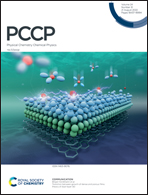Recognition between CD147 and cyclophilin A deciphered by accelerated molecular dynamics simulations†
Abstract
CD147 functions as the receptor of extracellular cyclophilin A (CypA) in various diseases, and CD147–CypA binding ulteriorly underlies the pathological process of various viral infections including HIV-1, SARS, and SARS-CoV-2. Although CyPA has been identified as a key intermediate pro-inflammatory factor, the mechanism by which CD147 cooperates with CypA in the development of the cytokine storm remains largely unknown, and the binding profile of CD147 with CypA remains to be elucidated as well. Here, we prepared three binding models of the CD147–CypA complex, including the active site of CypA severally binding to the groove bound by the Ig1 and Ig2 domains (model-0), P180-G181 (model-1), and P211 (model-2) of CD147, as well as introducing mutations P180A-G181A and P211A individually in each model. All systems were studied using accelerated molecular dynamics simulations and the molecular mechanics generalized Born surface area (MM/GBSA) method. For model-0, CypA bound to the ectodomain of CD147 with the highest binding affinity. Moreover, mutations P180A-G181A of CD147 in model-0 decreased the binding affinity and weakened the dynamic correlation between CD147 and CypA, which resulted in CypA shifting from the initial binding location. Other residue mutations of CD147 did not significantly affect the CD147-CypA binding, as reflected by the energy and structural analyses. Compared with surface plasmon resonance results and nuclear magnetic resonance shift signals, CypA should tend to reciprocally bind to the groove of CD147, and the binding process might be modulated by P180-G181 rather than P211. Besides, residue R201 of CD147 is critical for CD147-CypA binding and needs further experimental verification. These findings further our understanding of the recruitment between CD147 and CypA and its potential role in the development of inflammation and viral infection.



 Please wait while we load your content...
Please wait while we load your content...